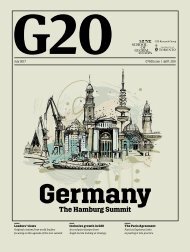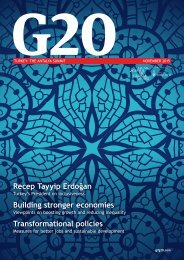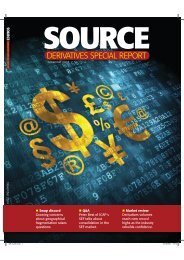G20 china_web
You also want an ePaper? Increase the reach of your titles
YUMPU automatically turns print PDFs into web optimized ePapers that Google loves.
Regulating finance<br />
KEY TAKEAWAYS<br />
An increase in China's non-performing<br />
loans (NPLs) is causing concern<br />
An increase in NPLs is normal during<br />
periods of economic transition<br />
Creating<br />
better banking<br />
If the last decade has taught us anything, it is that the global<br />
banking practices are far from perfect. Zhang Yanling looks<br />
at what can be done in banking to promote Chinese reforms<br />
In Brisbane in 2014, when the <strong>G20</strong>’s<br />
focus was on the money shortage<br />
in China in 2013, I outlined how the<br />
situation would be improved. Since<br />
then, this problem has been solved<br />
quite successfully.<br />
Today, the main concern about China’s<br />
economy focuses on the banking sector’s<br />
non-performing loans (NPLs). By the end<br />
of May 2016, NPLs exceeded two trillion<br />
RMB, up 0.16 per cent since the beginning<br />
of the year. The NPL rate has now risen<br />
to 1.75 per cent of all loans, with another<br />
4.01 per cent falling into the next-worse or<br />
‘special mention’ category. This increase in<br />
bad loans will inevitably lead to a decline<br />
in profits. In 2011, profits in China’s banking<br />
sector surpassed 36 per cent. In 2015,<br />
they were only 2.4 per cent. The NPL rate<br />
in China is causing widespread concern<br />
worldwide, casting China’s financial<br />
sector in an unfavourable light. Headlines<br />
proclaiming that China has the biggest NPL<br />
banks or that financial risk is the biggest<br />
uncertainty troubling China’s economy<br />
understandably make people uneasy.<br />
However, a few points should be made.<br />
NPLs on the rise<br />
First, most NPLs can be traced back to<br />
when the economy was booming. When an<br />
economy grows fast, bank loans expand<br />
rapidly and the NPL rate becomes diluted<br />
by fresh loans. However, today, during the<br />
economic transition, China’s government<br />
is implementing measures to cut excess<br />
production capacity, adjust the overall<br />
national economic structure and de-stock<br />
inventory. In this environment, the growth<br />
of bank loans slows down considerably,<br />
no longer diluting the NPL rate as much.<br />
The absolute number of NPLs is shooting<br />
up, because some enterprises are short<br />
142 <strong>G20</strong> China: The Hangzhou Summit • September 2016 G7<strong>G20</strong>.com
















